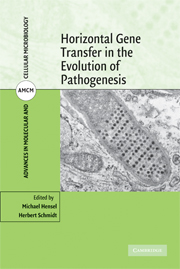Book contents
- Frontmatter
- Contents
- Preface
- Contributors
- PART I Theoretical Considerations on the Evolution of Bacterial Pathogens
- PART II Mobile Genetic Elements in Bacterial Evolution
- PART III Paradigms of Bacterial Evolution
- PART IV Interkingdom Transfer and Endosymbiosis
- 12 Eukaryotic Gene Transfer: Adaptation and Replacements
- 13 Lessons in Evolution from Genome Reduction in Endosymbionts
- Index
- References
12 - Eukaryotic Gene Transfer: Adaptation and Replacements
from PART IV - Interkingdom Transfer and Endosymbiosis
Published online by Cambridge University Press: 16 September 2009
- Frontmatter
- Contents
- Preface
- Contributors
- PART I Theoretical Considerations on the Evolution of Bacterial Pathogens
- PART II Mobile Genetic Elements in Bacterial Evolution
- PART III Paradigms of Bacterial Evolution
- PART IV Interkingdom Transfer and Endosymbiosis
- 12 Eukaryotic Gene Transfer: Adaptation and Replacements
- 13 Lessons in Evolution from Genome Reduction in Endosymbionts
- Index
- References
Summary
INTRODUCTION
The current view of eukaryote phylogeny indicates that microbial eukaryotes (protists) represent the vast majority of the biological diversity within the eukaryotic domain of life, and that multicellular eukaryotes have evolved from protist lineages several times independently (Adl et al., 2005). Accordingly, most eukaryote genome evolution has occurred in microbial lineages, and multicellular eukaryotes with sequestered germlines, such as animals and plants, should be seen as recent evolutionary exceptions, rather than the norm, within the eukaryotic domain (Figure 12.1). Yet, most knowledge about eukaryotic genome evolution comes from multicellular organisms and a few representatives of unicellular lineages, such as yeast. Fortunately, this narrow view of eukaryote genome evolution is now expanding with the advance of genomic sequences from diverse protist lineages.
Several aspects of the lifestyles of protists are more similar to prokaryotic organisms, than to multicellular eukaryotes; differentiation into germ and soma cells are rare, and protists often live in close contacts with cells of distantly related species in the environment. Furthermore, many protists have asexual life cycles, although meiosis appears to be ancestral to eukaryotes (Ramesh et al., 2005). These similarities suggest that protists may share some aspects of genome evolution with prokaryotes. As is obvious from this book, the transfer of genetic material between unrelated lineages, lateral (or horizontal) gene transfer (LGT), is a fundamental mechanism in prokaryotic genome evolution, resulting in genomic plasticity which, for example, provides the basis for adaptation processes (Boucher et al., 2003; Gogarten and Townsend, 2005; Pál et al., 2005).
- Type
- Chapter
- Information
- Horizontal Gene Transfer in the Evolution of Pathogenesis , pp. 293 - 316Publisher: Cambridge University PressPrint publication year: 2008
References
- 2
- Cited by

